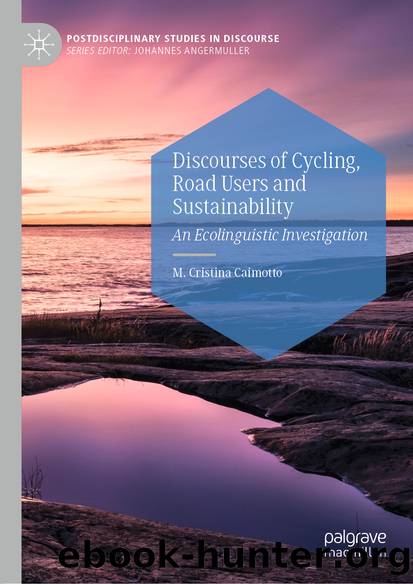Discourses of Cycling, Road Users and Sustainability by M. Cristina Caimotto

Author:M. Cristina Caimotto
Language: eng
Format: epub
ISBN: 9783030440268
Publisher: Springer International Publishing
4.4 Concluding Remarks
What are we to make of the observations reported in this chapter? Mainstream media reports concerning a trial against one person who killed another person in an unusual, unlikely and unexpected way reveal discursive strategies that have much in common with the strategies employed by other journalists to save their face against (expected) accusations of racism. The process observed in both situations is that one characteristic of the individual(s) being criticised for their actions is foregrounded, and this shifts the focus from the individual(s) to an imagined group or community of people who share that specific foregrounded characteristic and thus the group, not the individual, becomes the object of criticism. This generalisation against a community can be judged negatively, so the journalists need to prevent negative judgment by denying that they are making an overgeneralisation and by pre-emptying criticism. The further step is that the people who denounce and try to solve the problems experienced by those who belong to that imagined group or community are portrayed in the media as ‘the real enemy’.
What is the focus, why is this parallel discrimination significant? The parallel discursive features observed can contribute to the understanding of the excess of hate suffered and reported by people who advocate in favour of better cycling infrastructures. Just like racism, bikelash and deliberate aggressive behaviour against pro-cycling parades are driven by irrational and misplaced fears of change. In order to understand this, we need to enlarge the focus on a wider perspective. Shaer’s quotation (2011) reported in Wild et al. (2018) significantly employs another water metaphor ‘bike lanes have gone from simple strips of pavement festooned with green and white paint to sponges for a sea of latent cultural and economic anxieties’, which also in this case is connected with Charteris-Black’s above-mentioned observation about social change. Wild et al. provide a useful reflection on the shades of discontent that bikelash embeds and offer practical solutions to address them and improve the effectiveness of bike schemes. But a deeper, further reflection is required if we want to recognise the true nature of the opposition against people who cycle, and especially against those who want to be able to cycle to more places and more often.
Poli (2011, 164–166) envisages three approaches to traffic policy, ‘traditional’, ‘moderate reform’ and ‘revolution’. In a traditional approach the planning relies on revealed preferences, thus reinforcing the current trends, following the preferences revealed by the market. In terms of traffic policy it means that ‘if roads are filled with cars, it means that we have to build more roads to respond to the demand’ (164). The second option of moderate reform tries to invert the growing trend in car use by increasing public transportation. It tries to respond to the existing transportation needs by simply changing part of the mobility choices. This option is welcomed by many environmentalists and, Poli explains, matches the sustainable development idea, as ‘in the attempt to involve traditional industry in environmental projects, the sustainable growth environmentalists have become lost in convenient negotiations and have forgotten the real goals’ (166).
Download
This site does not store any files on its server. We only index and link to content provided by other sites. Please contact the content providers to delete copyright contents if any and email us, we'll remove relevant links or contents immediately.
The Art of Coaching Workbook by Elena Aguilar(48028)
Trainspotting by Irvine Welsh(20042)
Twilight of the Idols With the Antichrist and Ecce Homo by Friedrich Nietzsche(17702)
Fangirl by Rainbow Rowell(7825)
Periodization Training for Sports by Tudor Bompa(7322)
Change Your Questions, Change Your Life by Marilee Adams(6633)
This Is How You Lose Her by Junot Diaz(5751)
Grit by Angela Duckworth(4728)
Red Sparrow by Jason Matthews(4653)
Asking the Right Questions: A Guide to Critical Thinking by M. Neil Browne & Stuart M. Keeley(4559)
Paper Towns by Green John(4163)
Room 212 by Kate Stewart(4097)
Ken Follett - World without end by Ken Follett(3968)
The Sports Rules Book by Human Kinetics(3580)
Housekeeping by Marilynne Robinson(3394)
The Motorcycle Diaries by Ernesto Che Guevara(3325)
Introduction to Kinesiology by Shirl J. Hoffman(3297)
Exercise Technique Manual for Resistance Training by National Strength & Conditioning Association(3285)
Double Down (Diary of a Wimpy Kid Book 11) by Jeff Kinney(3266)
